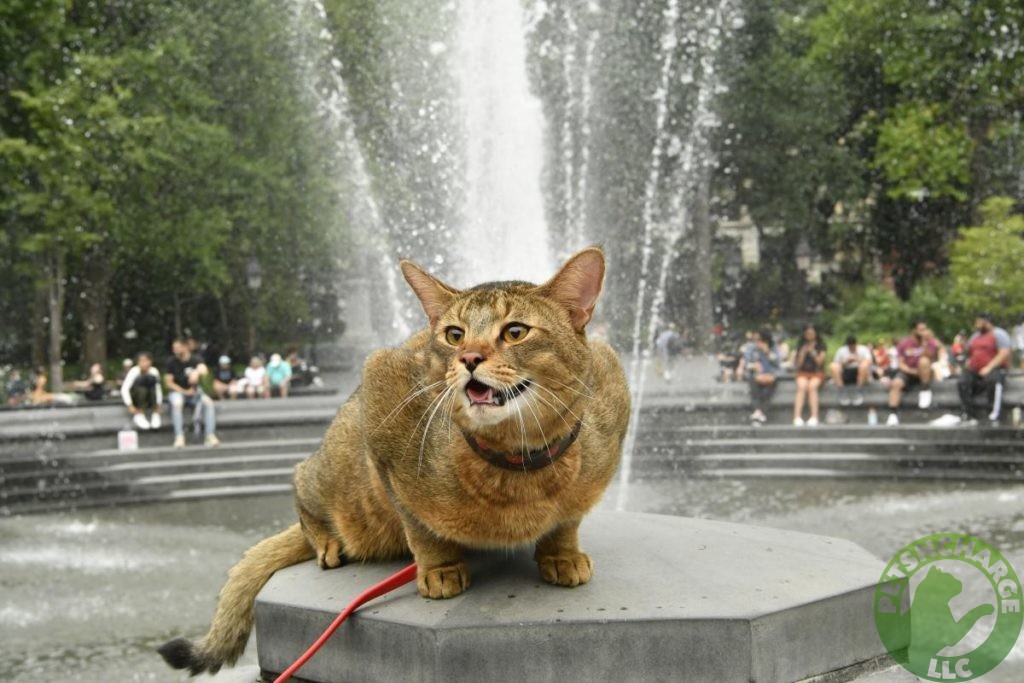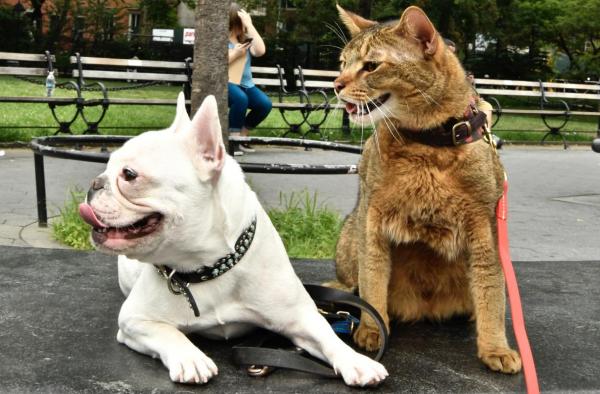
With dogs, it’s important to understand that they instinctively chase prey. Whether it’s a squirrel, a bird, a ball or even a CAT, all the dog sees is a fast- moving toy/prey. Luckily, dogs have a fantastic sense of smell and they can be taught to use it to distinguish and find many objects and animals. The key is slowing them down long enough to recognize, via scent, that the quickly moving entity is, for instance, a cat, NOT a toy or food source. Training the dog to ignore it (“Leave it!”) gives the dog time to engage his nose and learn that the scent belongs to the cat and that the cat is part of the family. Dogs do not want to hurt family members. Cats will run, taunt and act like prey. There is always an instigator and it is usually the cat. Even when the dog stops chasing and is leaving the cat alone, the cat will still bother the dog. In fact, the cat WILL try harder/come closer to entice the dog to chase. Why? IT’S A CAT! Unfortunately, the dog is to blame when the cat is either upset or harmed. To avoid this, the dog requires clear and consistent training — which again requires ample patience — to be able to control his natural instincts to chase the cat. With time, the dog will understand cat scent=family member, NOT prey. When the cat learns that the dog won’t chase, the cat will stay closer to the dog. Getting to be near the cat, THAT IS THE REWARD FOR THE DOG. At this point, you can use treats to lure the cat closer to the dog. The treats are the cat’s reward for staying near the dog. Always be careful in case the cat spooks. Why? IT’S A CAT and you never want the cat to feel trapped since the cat might try to use you as a tree to escape (and this is very painful). Note on Most Commercial cat treats: They are not good for Dogs and can make them sick. I use Dehydrated/Freeze Dried Chicken or Salmon which is Healthy for both Cats and Dogs.

The Training Process can be quicker with puppies, but they need to learn boundaries so that, as they grow, their instinct to chase does not extend to cats. Keep in mind that it is much harder for a dog to unlearn bad behavior than it is for him to learn good behavior from the beginning.
I never encourage dogs to chase any breathing thing, with the exception of dogs used specifically for hunting game and that is specialized Training.
Allowing your dog to chase rabbits may look cute, but hearing that rabbit SCREAM when being torn apart will change your mind very fast. If you have a dog breed that needs to chase, use toys, balls and flirt poles to drain the prey energy in a constructive way. A high-energy dog needs to use up its energy somehow. A long walk, a fetch session or even some time on a treadmill will help. A tired dog is less likely to shred the house and chase the cat, especially if the dog is already receiving consistent training as outlined above.(with Puppies under 18 months Use of a Treadmill should be limited/no incline and very short sessions-Their hips are still forming).

Keep in mind your breed of dog. Read about the breed, preferably before you make it a member of your household. For many working dog breeds, exercise alone is not enough; they need constant physical and mental gymnastics. You need to give them things to do. Sitting, lying down and staying put can be an activity for them. Adding these types of exercises when someone comes to the door can teach patience and obedience as well as making them feel useful. Most people lock the dog up when they answer the door, which both frustrates the dog and makes him fearful when the bell rings — “I am being locked up; it must be danger.” In the beginning, you should use a collar and leash, but with practice and patience, the once barking dog will quietly sit or lie down on command and then you can have a conversation with the visitor and/or invite him in. As the dog gets more confident that the ring of the doorbell does not require a rise to action, he’ll remain calm. At that point in the training, you can ask the visitor if he likes dogs and, if the answer is yes, encourage the dog to “say hello” or whatever word(s) you want the dog to associate as permission to greet the person. Remember, whatever wording you choose to use, you must be consistent with it. You must also take human behavior into account — most people do not know how to greet dogs appropriately. Often, they will pat the dog on its head which is not ideal and can be unsafe, as it covers the dog’s eyes and can scare him. You can set your guests (and your dog) up for success by asking them to present their hand, palm-up, under the dog’s chin so he can first smell the human being introduced. If the dog and visitor are calm and relaxed, you can practice patting and other “not ideal” dog greeting/affection to de-sensitize the dog when approached inappropriately. This may sound crazy, but it will pay off later. Bottom line, it’s easier to teach the dog than the human, but it does require practice and patience. Cats may act like prey but humans can be even worse in this regard. Teaching your dog not to chase or react to a fearful human is very important. I use the same command — “Leave it!” — regarding both cats and fearful humans. This will not affect the dog’s ability to protect you, but it will reinforce your ability to control the dog. If the dog is not fearful, he will be confident and happy in his surroundings. He finds comfort not only food and shelter, but also in the time you take to assure and teach him. A bored, untrained dog will ruin your home and sanity. The earlier you start training — preferably at the puppy stage — the easier it will be. An older dog can learn, but will require more time and patience to do so. The key is PATIENCE and exposure to the world. The more they are introduced to, the better. Providing your dog with good, consistent training will make his exploration of the world fun and exciting. Using the command “Leave It!” or ”Ignore!” when you walk by something that could be intimidating will reassure the dog that since you said to ignore it, it must be okay. I started this as a Cat and Dog guide; however, the unpredictability of the cat is very similar to the unpredictability of people and life. The dog’s ability to filter out strange noises, people and places can start simply with learning to coexist with a cat. Cats make the strangest noises and they often taunt and pop out from obscure places.
Knowing your Dog breed is important when trying for harmony and peace in the home. There are some dog breeds that should not live with cats. These are not bad dogs, but dogs that are bred/designed to kill and/or battle their prey. They have an extreme kill drive that will prevent them from being able to control their kill instincts. This is different from prey drive which all dogs have naturally. Yes, there are exceptions in all breeds, but is it worth the risk if you can avoid it? It is unfair to set up both the cat and the dog for failure in these circumstances. Usually THE CAT IS KILLED BY THE DOG. If you are aware of these traits in your breed of dog, it’s your fault if the dog kills the cat! Making an exception may seem okay until the cat is torn apart — and I mean “ACTUALLY TORN APART” — by the dog. I can never forgive the person who told me that her Jack Russell terrier killed her cat and then got another cat who was also killed by that same dog! The person knew better — she knew the dog Liked to killed vermin and considered cats vermin — so the person is responsible for the cat’s unnecessary death. Also, if a breed will kill a cat, it can kill a baby or small child. These predatory breeds have trouble distinguishing play from kill instincts and can switch from one to the other in a split second. This is not enough time for a human to intervene and save the cat or child from being mauled by the dog. If the dog is bred to kill/be a predator, he does not know he is doing anything wrong — to him, anything weaker is fair game. Defining breeds for cat suitability:
Bred to find, hold and KILL prey = PREDATOR, NOT SUITABLE
Bred to find and show (point/flush) prey = sporting/hunting, can be SUITABLE with proper training
Bred to herd prey/animals = SUITABLE with proper training
Bred to eliminate vermin = NEVER SUITABLE (most Terriers fall into this category)
When training cats and dogs:
BE PATIENT!
BE REALISTIC!
NO ANGER — CATS WILL BE CATS AND DOGS WILL BE DOGS.
Achieving harmony between cat and dog can take time, many MONTHS in some cases. ALWAYS give the cat an escape; gates with cat doors and shelves are useful, the latter providing them with plenty of vertical space to get out of harm’s way. The most basic method of animal introduction happens via getting them used to each other’s scent. Wrap two blankets around you so your scent is on them. Then put one where the cat sleeps and the other where the dog naps. Alternate the position of the blankets every day. The familiar scent — your scent — mixed with their scent will ready them for the next part. If the blankets have had enough time to work, the cat smells like you and the dog. Being near the cat makes the dog happy since being near you makes the dog happy.
CATS: Cats will act like prey.
Cats will run from dogs.
A Cat’s favorite game is “taunt-the-dog.”
DOGS: Dogs want to chase prey.
Dogs can learn to “Leave It” and that command applies to anything you want the dog to ignore.
Dogs will learn that a cat is not prey and will want to be near it.
Use common sense, don’t let the dog loose until he has learned “LEAVE IT”, “COME” and “DOWN” with confidence. The dog can run around the house with a Drag leash or a PROPERLY introduced Ecollar.. Ecollar’s are not for punishment but an extension of you. Saying “LEAVE IT” with a buzz(tone or light stim) can reinforce the hard work you have done and ease your mind that the cat won’t be harmed. Remember the Ecollar is not to be used to punish, you don’t want the dog to think of the cat as pain. Also if not properly introduced the dog with have no idea what the collar is for. A good trainer can help in the proper use and introduction of the Ecollar. Using Common Sense will Set you us for a Lifetime of Harmonious Pet Companionship.

Lena is the CEO of Petsncharge LLC. She is a pet owner, animal lover, trainer, rescuer and an advocate. Follow her on Twitter, Facebook, Instagram and Reddit.
Don’t miss out, get on the mailing list today!


